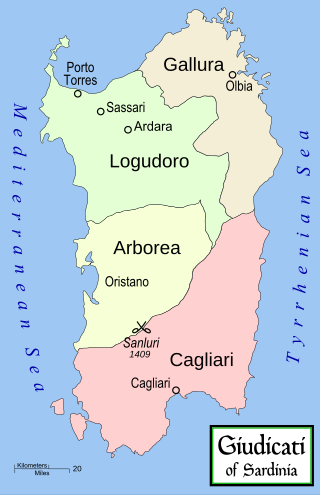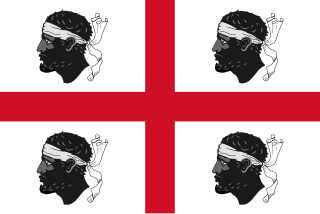
Archaeological evidence of prehistoric human settlement on the island of Sardinia is present in the form of nuraghes and other prehistoric monuments, which dot the land. The recorded history of Sardinia begins with its contacts with the various people who sought to dominate western Mediterranean trade in classical antiquity: Phoenicians, Punics and Romans. Initially under the political and economic alliance with the Phoenician cities, it was partly conquered by Carthage in the late 6th century BC and then entirely by Rome after the First Punic War. The island was included for centuries in the Roman province of Sardinia and Corsica, which would be incorporated into the diocese of Italia suburbicaria in 3rd and 7th centuries.

Oristano is an Italian city and comune, and capital of the Province of Oristano in the central-western part of the island of Sardinia. It is located on the northern part of the Campidano plain. It was established as the provincial capital on 16 July 1974. As of December 2017, the city had 31,671 inhabitants.

Eleanor of Arborea or Eleanor De Serra Bas was one of the most powerful and important, and one of the last, judges of the Judgedom of Arborea in Sardinia, and Sardinia's most famous heroine. She is also known for updating of the Carta de Logu, promulgated by her father Marianus IV and revisited by her brother Hugh III.

The Judicates, in English also referred to as Sardinian Kingdoms, Sardinian Judgedoms or Judicatures, were independent states that took power in Sardinia in the Middle Ages, between the ninth and fifteenth centuries. They were sovereign states with summa potestas, each with a ruler called judge, with the powers of a king.

The Judicate of Arborea or the Kingdom of Arborea was one of the four independent judicates into which the island of Sardinia was divided in the Middle Ages. It occupied the central-west portion of the island, wedged between Logudoro to the north and east, Cagliari to the south and east, and the Mediterranean Sea to the west. To the northeast and beyond Logudoro was Gallura, with which Arborea had far less interaction. Arborea outlasted her neighbours, surviving well into the 15th century. At its greatest territorial extent it occupied the entire island except the cities of Alghero and Cagliari. The earliest known judicial seat was Tharros, though Oristano served as capital for most of its existence.

The Battle of Sanluri was fought on 30 June 1409 between the armies of the Sardinian Judicate of Arborea and the Aragonese-Sicilian army led by the King Martin I of Sicily.

Hugh Ijudike of Arborea from 1185 until his death in 1211. Hugh was the son of Ispella di Serra and Hugh I of Bas. He was a grandson -through his mother- of Barisone II of Arborea.

William I, royal name Salusio IV, was the judike of Cagliari, meaning "King", from 1188 to his death. His descendants and those of his immediate competitors intermarried to form the backbone of the Italian Aristocracy, and ultimately their descendants in the Medici clan are precursors to, and definers of later royalty and claims thereto.

The Kings or Judges of the Arborea were the local rulers of the west of Sardinia during the Middle Ages. Theirs was the longest-lasting judgedom, surviving as an independent state until the fifteenth century.

Marianus IV, called the Great, was the Judge (king) of Arborea, kingdom in the island of Sardinia, from 1347 to his death. He was, as his nickname indicates, the greatest sovereign of Arborea. He was a legislator and a warrior whose reign saw the commencement of massive codification of the laws of his realm and incessant warfare with the Crown of Aragon. He was also a religious man, who had connections to Catherine of Siena. He was, in short, an "wise legislator, able politician, and valiant warrior."
Hugh II was Judge of Arborea, reigning from 1321 CE until his death in 1336 CE. He was the illegitimate son of Marianus III of Arborea and Paulesa de Serra.

Peter I, of the Serra family, was the eldest son and successor of Barisone II of Arborea, reigning from 1186 to his death. His mother was Barisone's first wife, Pellegrina de Lacon. He was crowned King of Sardinia, the title his father had used, with the support of a majority of the Arborean nobility.

Marianus II was the Judge of Arborea from 1241 to his death. With skilled military action, he came to control more than half of the island of Sardinia. By his control of the vast central plains and the rich deposits of precious metals, he increased the riches of his Judicate and staved off the general economic decline affecting the rest of Europe at the time.

Brancaleone Doria was the husband of Eleanor of Arborea, regent of the Giudicato of Arborea on the island of Sardinia in the late 14th century. He was a scion of the influential Doria family of the Republic of Genoa, the son of the elder Brancaleone and a woman named Giacomina. On 16 March 1357, he became a vassal of Peter IV of Aragon, the nominal King of Sardinia, to legitimate the possessions of his father on the island.

The Kingdom of Sardinia, also referred to as the Kingdom ofSardinia-Piedmont or Piedmont-Sardinia as a composite state during the Savoyard period, was a country in Southern Europe from the late 13th until the mid 19th century.

The Aragonese conquest of Sardinia took place between 1323 and 1326. The island of Sardinia was at the time subject to the influence of the Republic of Pisa, the Pisan della Gherardesca family, Genoa and of the Genoese families of Doria and the Malaspina; the only native political entity survived was the Judicate of Arborea, allied with the Crown of Aragon. The financial difficulties due to the wars in Sicily, the conflict with the Crown of Castile in the land of Murcia and Alicante (1296-1304) and the failed attempt to conquer Almeria (1309) explain the delay of James II of Aragon in bringing the conquest of Sardinia, enfeoffed to him by Pope Boniface VIII in 1297.

Leonardo Alagon, even Alagón or de Alagón,, was the last marquis of Oristano (1470–1478).

The Marquisate of Oristano was a marquisate of Sardinia that lasted from 1410 until 1478

The Sardinian–Aragonese war was a late medieval conflict lasting from 1353 to 1420. The fight was over supremacy of the land and took place between the Judicate of Arborea -- allied with the Sardinian branch of the Doria family and Genoa -- and the Kingdom of Sardinia, the latter of which had been part of the Crown of Aragon since 1324.

The Kingdom of Sardinia was a feudal state in Southern Europe created in the early 14 century and a possession of the Crown of Aragon first and then of the Spanish Empire until 1708, then of the Habsburgs until 1717, and then of the Spanish Empire again until 1720.













